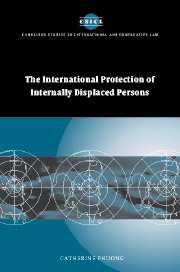Book contents
- Frontmatter
- Contents
- Acknowledgments
- Table of cases
- Table of treaties and other international documents
- List of abbreviations
- Introduction
- 1 Internally displaced persons and refugees: conceptual differences and similarities
- 2 The legal protection of internally displaced persons
- 3 The institutional framework of protection for the internally displaced
- 4 Protection strategies for the internally displaced
- 5 Case study: internal displacement in Bosnia and Herzegovina
- 6 Reconceiving sovereignty and intervention
- Conclusions
- Annex 1: The Guiding Principles on Internal Displacement
- Bibliography
- Index
- CAMBRIDGE STUDIES IN INTERNATIONAL AND COMPARATIVE LAW
2 - The legal protection of internally displaced persons
Published online by Cambridge University Press: 17 July 2009
- Frontmatter
- Contents
- Acknowledgments
- Table of cases
- Table of treaties and other international documents
- List of abbreviations
- Introduction
- 1 Internally displaced persons and refugees: conceptual differences and similarities
- 2 The legal protection of internally displaced persons
- 3 The institutional framework of protection for the internally displaced
- 4 Protection strategies for the internally displaced
- 5 Case study: internal displacement in Bosnia and Herzegovina
- 6 Reconceiving sovereignty and intervention
- Conclusions
- Annex 1: The Guiding Principles on Internal Displacement
- Bibliography
- Index
- CAMBRIDGE STUDIES IN INTERNATIONAL AND COMPARATIVE LAW
Summary
As demonstrated in the previous chapter, the concept of internal displacement needs to be distinguished from the concept of refugeehood. Refugees are covered by an ‘established’ regime of protection, but internally displaced persons, because they remain within the borders of their state, cannot benefit from it. Although the expression ‘internally displaced persons’ is not mentioned in any international legal instrument, this does not mean that the internally displaced do not enjoy any legal protection under existing international law. This chapter identifies the legal framework of protection for the internally displaced and demonstrates how it draws heavily on international human rights law. If work with the internally displaced must be pursued in a human rights framework, it must be based on the relevant provisions of human rights law as restated in the Guiding Principles on Internal Displacement.
The protection of internally displaced persons raises several issues. First, it is not clear what protection for internally displaced persons involves: broad interpretations have been adopted and have included at least protection against displacement and protection for those who are displaced. These two aspects were identified in the Analytical Report on internally displaced persons which concluded with the need for new human rights standards. Secondly, protection of internally displaced persons is a sensitive issue for reasons explained earlier: it has been feared that strengthening protection for internally displaced persons, i.e. in-country protection, would serve as a pretext for denying the possibility of protection abroad, i.e. asylum, hence the reluctance of some refugee lawyers to increase the focus on internally displaced persons.
- Type
- Chapter
- Information
- Publisher: Cambridge University PressPrint publication year: 2005



